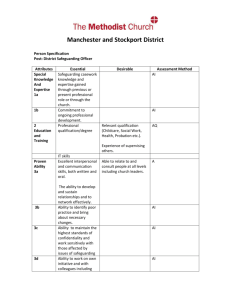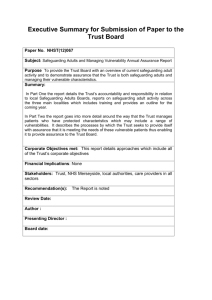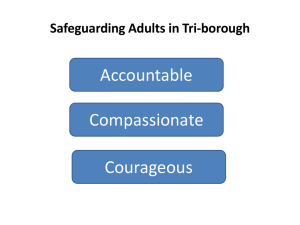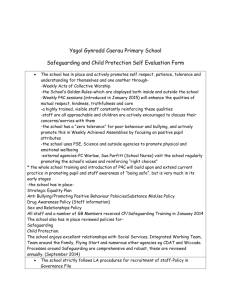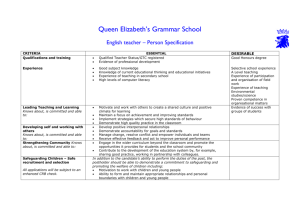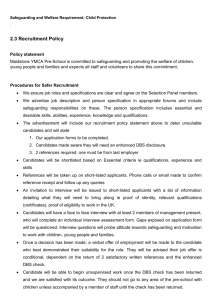20. Safeguarding in Schools booklet Sept 2014
advertisement
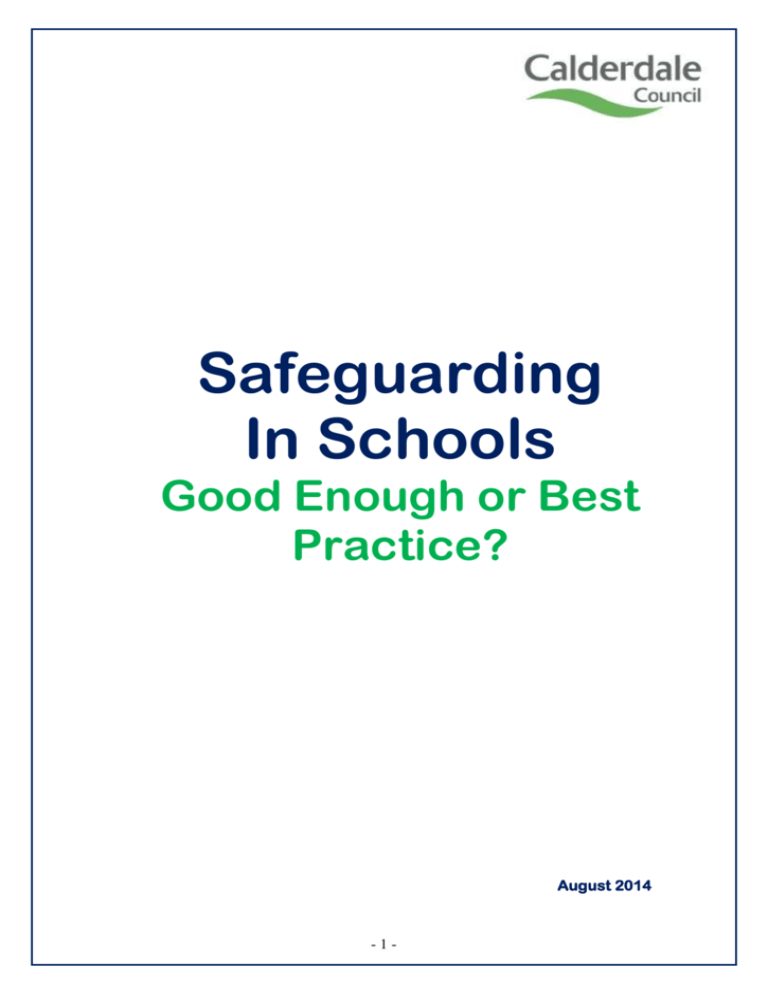
Safeguarding In Schools Good Enough or Best Practice? August 2014 -1- Contents 1. Purpose Page 3 2. Role & Responsibilities Page 4-7 3. Training Page 7-8 4. Guidance, Policies & Procedures Page 9-10 5. Identifying & Responding to Concerns Page 10-15 6. Recording, Record Keeping & Confidentiality Page 15-18 7. Allegations Against Staff Page 18-20 8. Safe Recruitment Page 20-23 9. Pupils Safety & Safe Practices Page 23-24 10. On & Off-Site Safety Page 25 11. Useful Contacts Page 26-30 -2- 1. Purpose The purpose of this guidance document is to set out some of the key responsibilities of the school, Governing Body and the Designated Safeguarding Lead (DSL). It focuses on what would be seen as ‘Good Enough’ to what has been highlighted as ‘Best Practice’. The hope is that schools can ensure that they have policies, procedures and practices in place that are meeting minimum requirements, but then that schools will aspire to adopt the best practice and become outstanding in terms of safeguarding. ‘Safeguarding in Schools: Best Practice’ (Ofsted 2011) highlighted the following: Weaknesses in safeguarding are usually related to broader failings in leadership, management and governance. Common themes include: A failure to maintain a single central record of recruitment and vetting checks covering all adults who had regular contact with children Insufficient child protection training Key risk assessments not completed Failure by the governing body to monitor and review the policies to protect children Common Features of Outstanding Schools: A culture where safeguarding is everyone’s business and everyone’s responsibility Safeguarding policies written in plain English, often exceeding minimum requirements Training is high priority and goes beyond basic requirements Accountability is established at all levels in the school QA is integral to daily practice and any findings are acted upon quickly Parents and children are involved at all levels Security is “tight but not obtrusive … visitors feel welcomed rather than scrutinised” -3- 2. Roles & Responsibilities Good Enough: Designated Safeguarding Lead (DSL) All schools must have a named Designated Safeguarding Lead. The role of the DSL is to take lead responsibility for managing child protection issues, providing advice and support to other staff, liaising with the local authority and working with other agencies. The DSL should be a member of the senior management team however they do not have to be a teacher. The broad areas of responsibility as stated in KCSE (2014) for the designated safeguarding lead are: Managing referrals • Refer all cases of suspected abuse to the local authority children’s social care and the local authority designated officer (LADO) for child protection concerns which concern a staff member; Disclosure and Barring Service where a person is dismissed or left due to risk/harm to a child; and/or Police where a crime may have been committed • Liaise with the head teacher or principal to inform him or her of issues especially ongoing enquiries under section 47 of the Children Act 1989 and police investigations • Act as a source of support, advice and expertise to staff on matters of safety and safeguarding and when deciding whether to make a referral by liaising with relevant agencies Training The designated safeguarding lead should receive appropriate training carried out every two years in order to: • Understand the assessment process for providing early help and intervention, for example through locally agreed common and shared assessment processes such as early help assessments • Have a working knowledge of how local authorities conduct a child protection case conference and a child protection review conference and be able to attend and contribute to these effectively when required to do so • Ensure each member of staff has access to and understands the school’s or college’s child protection policy and procedures, especially new and part time staff -4- • Be alert to the specific needs of children in need, those with special educational needs and young carers • Be able to keep detailed, accurate, secure written records of concerns and referrals • Obtain access to resources and attend any relevant or refresher training courses • Encourage a culture of listening to children and taking account of their wishes and feelings, among all staff, in any measures the school or college may put in place to protect them Raising Awareness • The designated safeguarding lead should ensure the school or college’s policies are known and used appropriately: • Ensure the school or college’s child protection policy is reviewed annually and the procedures and implementation are updated and reviewed regularly, and work with governing bodies or proprietors regarding this • Ensure the child protection policy is available publicly and parents are aware of the fact that referrals about suspected abuse or neglect may be made and the role of the school or college in this • Link with the Local Safeguarding Children Board to make sure staff are aware of training opportunities and the latest local policies on safeguarding • Where children leave the school or college ensure their child protection file is copied for any new school or college as soon as possible but transferred separately from the main pupil file Best Practice: All schools should have more than one person DSL trained so that if the DSL is not available there is at least one deputy who has full access to the files, understands the policies and processes and takes an active role in Safeguarding within the school. This person is not always a member of the senior management team however they should if not report directly to the DSL. -5- With regard to the broad responsibilities referred to above: Managing Referrals • • Ideally the DSL and any deputy(s) work as a team to have discussions about thresholds, interventions and referrals, and these decisions are supported by tools such as the Continuum of Need and the Assessment Framework (included later in this document) The DSL could produce a half-termly Safeguarding Report to the Governing Body or equivalent (Could be within HT Report). This would present the safeguarding issues being managed within the school eg. Number of children on CAFs Raising Awareness • • To ensure that the school’s child protection policy is available it should be available on the School Website so that all members of the school community can access it when required When transferring Child Protection files to a new education establishment this should be done by hand and a copy should be kept until the child’s 25th birthday Training • • • • To ensure that the DSL or Head fully understand the role of the Calderdale Safeguarding Children Board they could volunteer to be a member of the Board or one of the sub-groups. Completion of the Section 11 audit would be good evidence that the school works with the Board and understands its monitoring role To ensure that staff have good working knowledge around Safeguarding, the DSL should provide annual top-up training at the start of each academic year, either delivered by them or a trainer approved by the Calderdale Safeguarding Children Board. To ensure that the DSL keeps up to date and informed, as well as attending the mandatory refresher training every two years they could also attend Multi-Agency training provided by the Calderdale Safeguarding Children Board, access other training opportunities identified to meet the needs and issues of their school community, and regularly attend and contribute to the termly DSL Network Meetings. Schools should also be accessing training specific to their own identified needs or issues eg. If school has particular concern around self-harm. Everyone within the school community including teaching staff, non-teaching staff, governors, volunteers, parents and children should be aware of who both the DSL and the deputy DSL are. -6- Ideally this should be displayed around the school and below is an example of a poster/leaflet that could be used for this purpose: We are here to talk to if you feel unsafe or if you are worried about someone else Designated Safeguarding Lead (DSL) Mr Maths Deputy DSL Mrs English Sunshine Primary School The posters should be at child height to ensure that the children in the school can actually see them. It would be unrealistic to think that children will always and only go to these people however it is important that they know that certain people have this role and that if they tell someone else something then they understand that these people may be told. The school website is also a really helpful place to have this information so that parents can see who these people are and can gain some understanding of what the role involves. Safeguarding newsletters or similar can be really effective to keep parents engaged with the Safeguarding Policies or Procedures or to involve them if you are focusing on a particular issue or topic within the curriculum eg. Bullying. On these newsletters you can have the DSL and deputy DSLs names and contact details as a footer again to reinforce this role within the school community. The school community should also be aware of who the Safeguarding Governor is. 3. Training Good Enough: Training for the DSL is updated every two years and all staff have appropriate and relevant training which is regularly updated. -7- Best Practice: Regular and up to date training is essential to ensure that there is a Safeguarding ethos within school and that everyone involved with the school sees it as a priority. Ideally whole school training should genuinely involve all staff including teaching and non-teaching staff, lunchtime supervisors, Governors and volunteers. As previously mentioned the DSL could deliver an annual ‘top-up’ session at the start of each academic year for all staff, and then coordinate whole school training every three years provided by someone external. Online training can be used for this annual ‘top-up’ or as an effective mop-up arrangement. It is essential that any safeguarding training attended is recorded for all staff. The following documents are examples of how this information could be recorded: Designated Safeguarding Lead – Training Record Course/Forum Title Date Completed DSL Initial Training Sexually Harmful Behaviour CEOP Introduction DSL Refresher Training DSL Network Meeting CAPE Conference 10.09.11 20.03.13 05.06.14 08.09.13 12.07.14 13.03.14 Whole School Safeguarding – Training Record Course/Forum Title Delivered by No. of Date Staff Completed Whole School Basic Awareness Schools Safeguarding 35 11.09.11 Advisor Mop-Up Session Schools Safeguarding 10 09.11.11 Advisor Individual On line Training n/a 4 03.03.12 Safeguarding ‘Top-up’ DSL 45 04.09.12 Safeguarding ‘Top-up’ DSL 46 04.09.13 Date for Renewal 10.09.13 08.09.15 Date for Renewal 11.09.14 As Above As Above 04.09.13 04.09.15 (next year due for external delivery) -8- 4. Guidance, Policies & Procedures Good Enough: All schools need a Safeguarding and/or Child Protection Policy and this should be reviewed on an annual basis. Best Practice: Policies should be available to everyone in the school community, ideally through the school website. The Safeguarding Policy should comply with ‘Working Together to Safeguard Children’ 2013, the Calderdale Safeguarding Children Board procedures and the West Yorkshire Interagency Safeguarding Procedures, and ‘Keeping Children Safe in Education’ 2014. There are example policies and procedures available from the Schools Safeguarding Advisor. A good policy should include a statement of belief, vision and aspiration. There should also be detailed procedures which are the framework and explain how the policy is going to be met. A school policy does not exist once written, it is only a policy if developed and ratified by the Governing Body or equivalent, and ideally developed in consultation with partner agencies. A policy often does not change significantly from one year to the next, however any new guidance, wording and contact details should be checked and updated to ensure that it demonstrates that the school is up to date and aware. There are other Safeguarding policies which schools may need, and it is important that your policies are cross-referenced and again reviewed annually. All policies should be made available to staff, and best practice suggests that a register is kept and signed by staff as evidence that they have read and thus agreed to adhere to any policies. The following is a list of policies that the school may need but please be aware that this is not an exhaustive list but merely a guide of what can be expected. This format can be a helpful record to ensure that all policies are up to date and reviewed appropriately, and ratified by the Governors. -9- Policy Date of Production Date of Review Review Completed By Governor Signed Off Date Safeguarding & Child Protection Anti-bullying Policy Behaviour Policy Health & Safety Policy E-Safety Policy School Trips, Work Experience & Off-Site Activities Policy Medical Needs & Administration of Medicine Policy School Security Policy Attendance Policy Managing Allegations Against Staff Special Educational Needs Policy Whistle Blowing Policy Staff Code of Conduct 5. Identifying & Responding to Concerns Good Enough: All staff are aware of the different types of abuse and pass concerns to the DSL. The DSL refers to the Multi-Agency Screening Team (MAST) if they have serious concerns about a child. This decision is based on one persons’ opinion using their judgement. Best Practice: All staff and volunteers within school are clear on the key signs and symptoms of the different types of abuse and/or safeguarding concerns, and this information is refreshed through whole school training. They are then clear on what they do if they then identify a concern or receive a disclosure, as this is clearly set out in the procedures contained within the Safeguarding/Child Protection policy. The DSL receives concerns through a consistent and rigorous process and this works exactly the same whether the DSL is present or not. The DSL then uses the Continuum of Need and the Assessment Framework to make a decision about what level of risk and need the child is at. - 10 - The following flowchart is an example of how the process may work within school – this can be made relevant to each school by adding names and other details and then ensuring that it is regularly updated: - 11 - Concern identified or disclosure received Information passed to DSL or deputy DSL and Record of Concern form completed if necessary Discussion with parents – DSL to decide who does this Discussion with child – DSL to decide who does this Monitoring – where is this being recorded? Actions and review information recorded on Record of Concern and CP file created Decision made about threshold level using the Continuum of Need Level 1 Universal – needs met Continue to monitor through school no further intervention needed Level 2 Low Risk Single agency, single need Low level intervention at school Level 3 Medium Risk Instigate Single Assessment/ CAF process - CAF lead professional in school is ... Level 4 Medium/High Risk Refer to MAST as a Child In Need - Targeted or Specialist intervention Escalate if referral not taken at level required Feedback given to person who brought initial concerns - 12 - Level 5 High Risk Immediate referral to SCD as Child Protection concerns If the concern is at a lower level the DSL and other key members of staff are aware of other interventions available either through the school or by referring to the Early Intervention Panels. The DSL and other key members of staff understand the Early Intervention process and engage in this when appropriate. If the DSL is unsure about which threshold a child is at you can now contact the MAST Information and Advice helpline to discuss this further. This will help to determine whether a referral meets the threshold for Social Care intervention and will be recorded as a Contact. The outcome of this phone call will be a decision about whether a Referral is required or not. You can contact the Multi-Agency Screening Team (MAST) on: Secure e-mail: MAST@calderdale.gcsx.gov.uk Fax: 01422 392875 Telephone: 01422 393336 - 13 - Here are a few things which may improve your Request for Service/Referral to MAST if this is deemed necessary: • Put your main concern or need first – why are you referring today? • If you refer, be available for a phone-call back or provide an alternative number where you or someone who knows about the referral can be contacted • Use plain English and remember that they do not know the child • Don’t forget the basics – full name/alias, dob, address • Include the Unique Pupil Number (UPN) • Include information about attendance • Only include key information - Who, what, where, when - If this is about an injury – is there a visible bruise? - Is this current/historical or both? - You don’t need to include all the historical information – need to set context but other than that MAST may already have or they can contact you for more if you indicate that there is some - Chronology • Say what has already been tried eg. school interventions or services provided by others. • Say whether parents have been spoken to and if not why not – be clear about whether you have consent • Family composition – really helpful to link to siblings or other referrals • Check if sibling’s schools have any concerns or information • Don’t just list – analyse - focus on Risk and Protective Factors • Proof read your referral • If it’s gut instinct/expert judgement that’s driving you, say so • If you’re not getting the response you want – is it clear what you want or is what you want realistic? • If you have referred before or you know the child is known to Social Care and you have their CASS Reference Number include it • Escalate/Challenge – research from SCRs, often initial referrals are not followed up Always remember to thank anyone who brings a concern to the attention of the DSL or deputy DSL, this increases people’s confidence to do so in the future and reinforces the fact that safeguarding is a priority. It is also important that the person who raises that concern receives some feedback. This does not need to be detailed or constant, however this person may be upset, anxious or just worried that they have done the right thing so reassurance that something is happening is incredibly valuable. If you are sending information by email you are advised to use either a secure email address or to password protect any documents which you attach. If you do have a GCSX email address, please remember that this is only secure if the person receiving the email also has a secure system. Some commonly used secure email systems are listed below: - 14 - Probation Email addresses ending with gsi.gov.uk Health Email addresses ending nhs.net Police Email addresses ending in pnn.police.uk CAFCASS Email addresses ending with gsi.gov.uk Local Authority Email addresses ending gcsx.gov.uk If you have children subject to a Child Protection Plan these will be managed by the Locality Teams. It is vital for working together that the DSL and the Social Worker establish and maintain a positive working relationship with the best interests of the child at the forefront. If you have a child subject to a Child Protection Plan it is vital that you can evidence that you contribute to and prioritise Initial and Review Child Protection Case Conferences and Core Groups. Likewise if you have a child that is Looked After, it is vital that you can evidence that you contribute to and prioritise Children Looked After reviews. If you are receiving and sending information related to Child Protection or Children Looked After this should be done securely using the School ‘drop box’ or ‘portal’. This should be checked regularly and you need to ensure that the appropriate people have access and receive the alert emails. If there are concerns with Children’s Social Care you can always escalate these to the Team Manager for the relevant team in the first instance. If resolution is not reached at this stage, the Service Manager would then look to resolve the issue. 6. Recording, Record Keeping & Confidentiality Good Enough: Records are kept of all concerns and these are placed in Child Protection files for the child they concern. These records are kept in a locked cabinet with limited access. When a child is transferred to another school, the Child Protection file is sent separately to the main pupil file. The DSL is aware of what safeguarding issues the school has and can provide this information if requested. - 15 - Best Practice: All child protection concerns should be recorded on a ‘Record of Concern’ or ‘Cause for Concern’ form. These should be completed by the person who encountered the concern either through observation or a disclosure. The DSL should then receive this form as soon as possible so that they can act on the information it contains. The information in the form should clearly distinguish between fact, observation, allegation and opinion, and should clearly state the name, the date, the event, a record of what was said and any action taken. This should provide a chronological record of what happened next. Ideally these forms should be printed on coloured paper to distinguish them from all the white paper used within schools. If a ‘Record of Concern’ form or similar is completed then a file should be started for that child or young person and this would then become their Child Protection file. All Child Protection files should be kept separately and securely in a locked cabinet with access limited to the Head teacher, the DSL and the deputy DSL. When a child is transferred to another school, the Child Protection file, where possible, should be delivered by hand and always separately to the main pupil file. A synopsis/chronology should then be kept until the child’s 25th birthday, so as to provide a clear audit trail. If the child is moving outside the district then the file can be posted however ensure that this is sent by recorded delivery with the ‘Signed For’ facility. The following form can be a useful record of file transfer to keep with the retained synopsis/chronology: Name of Child: School Transferred from: Date of Transfer: File Transferred Hand/Post by: Person delivering/sending file: Name: Person receiving file: Name: Date of Birth: School Transferred to: Date File Transferred: Date File Received: Signature: Signature: - 16 - Some schools choose to colour code their Child Protection files. This can be an effective way to ensure that you are aware of how many children are at each stage, and to ensure that you respond to any new concerns efficiently. One example is: Pre-CAF – All files have blue strip CAF – All files have green strip CIN – All files have yellow strip CP – All files have red strip LAC – All files have purple strip If you then have a School Community list which contains all the children and young people who have a Child Protection file you can ensure that these match and you keep on top of each child and their particular needs. If you have fewer children at these different stages this colour coding could be used within one Master file for each category. In terms of completing the ‘Record of Concern’ form or similar, it can be quite daunting for staff as they may only complete a small number if any throughout their time at your school. Some schools have therefore found it useful to dedicate a staff meeting to some tips in completing the forms and/or providing some good and not so good examples. It is important for the DSL to have a full understanding of the school community and the issues that particular children may have. A School Community list can be a useful way to keep and maintain this record, and have the information to hand to report to the Governing Body for example. Below is an example of what a School Community List could look like: Colour Number Code Issue Number of children with concerns (pre-CAF) Number of children subject to a CAF/Single Assessment Number of children at Child In Need Number of children subject to a Child Protection Plan Number of Looked After Children Number of children with a SEN statement Number of children with specific medical needs Number of CAF’s completed Number of Child In Need meetings attended Number of Child Protection Case Conferences attended Number of Child Protection Core Groups attended Number of referrals to MAST Number of referrals to LADO Number of reported bullying incidents & type of bullying - 17 - Other info/details Another alternative is to have an electronic system for recording concerns which should allow all the organisation referred to above and allow you to draw down reports. These reports can then be used to keep on top of the safeguarding issues you have within school, as well as for reporting purposes to the Governing body. CPOMS is an excellent example of this type of system currently available. 7. Allegations Against Staff Good Enough: All allegations made about a member of staff should be directed to the Head, or to the Chair of Governors if about the Head. These should be taken seriously and a referral should be made to the LADO if they meet the criteria. Best Practice: The school should have a specific ‘Managing Allegations Policy/Procedures’, or this should be included in the Safeguarding/Child Protection Policy, and reference should be made to the ‘Code of Safe Professional Practice’, ‘Staff Code of Conduct’ or equivalent. In terms of a process the following sets out the procedure as it should happen: Initial • • • • • Concern Concern reported to Head Teacher/COG/DSL Head Teacher and/or COG must be made aware Initial consideration internally i.e. does it meet criteria? Advisory discussion with LADO recommended Decision – if safeguarding issues are present refer to LADO Local Authority Designated Officer (LADO) The LADO should be consulted if the following criteria are met: “Where it is alleged that a person who works with children (this includes volunteers) have: • Behaved in a way that has harmed a child or may have harmed a child • Possibly committed a criminal offence against a child • Behaved towards a child in a way that indicates he or she would pose a risk of harm if they work regularly or closely with children” The Local Authority Designated Officer for Calderdale is Keith Watson and he can be contacted on 01422 394086 or by keith.watson@calderdale.gov.uk - 18 - Referral to Local Authority Designated Officer • Need a clear account of the concerns • Need personal details of the employee and any child concerned • Need summary of employment history and any previous concerns • Need details of other contact with children (own children, other jobs) • Need to complete key information in writing Local • • • Authority Designated Officer Process Discuss concern and jointly identify whether it falls within procedures Jointly identify any immediate action required to safeguard children If a child may have been harmed - LADO holds Strategy Discussion with Children’s Social Care • If a crime may have been committed – LADO holds Strategy Discussion with Police Safeguarding Team • Decision – is a Strategy Meeting required to enable multi-agency discussion/decision? • Plan agreed (e.g. action by employer, Strategy Meeting etc) Strategy Meeting • Chaired by Local Authority Designated Officer • Ideally, takes place before any investigation • Employers must be present (must be able to make decisions) • HR Provider • Children’s Social Care may be present • Police may be present • Enables joint decision about action to be taken by employer and partner agencies Possible Outcomes following investigation(s) Children’s Social Care: • May not meet threshold for referral • Investigation or assessment and no concerns • May identify support needs but no child protection concerns • May identify that the employee has harmed or poses a risk to children (may result in suspect being asked to leave the home, CP Conference, court proceedings) • Support for victim Police • • • • No investigation Investigation but no charge Cautioned Charged with an offence Management Investigation • No case to answer • Remedial measures by employer (e.g. additional training) • Formal verbal or written warning • Dismissal - 19 - It is important that staff are aware that these processes are in place and that the procedure is there to protect children but also staff members as it ensures that allegations are investigated thoroughly and objectively. Alongside these processes it is important that the school has considered and included within the policy what support and guidance will be offered to the member of staff who the allegation has been made against eg. referral to OHU, contact with Union. Staff should be aware that they have a responsibility to report any concerns that they have about a colleague, and that the welfare of the children within the school should be their priority over and above loyalty to staff members or volunteers. Serious Case Reviews such as Nigel Leat (2010) can help highlight these points. 8. Safe Recruitment Good Enough: It is imperative that schools have Safe Recruitment procedures in place to ensure that everything possible has been done to ensure that any staff and volunteers who work directly with children are safe and appropriate to do so. At least one member of any interview panel should have completed Safer Recruitment Training, and ideally this training ashould be attended by the Chair of Governors, the Headteacher and any other member of the Senior Management Team who may be involved in the recruitment process. Every school should also have a record of all staff and volunteers who work within the school and have contact with children within the school community, and this should be in the form of a Single Central Record, sometimes known as the Register. This should include: - all staff (including supply staff) who work at the school: in colleges, this means those providing education to children; - all others who work in regular contact with children in the school or college, including volunteers; - for independent schools, including academies and free schools, all members of the proprietor body. For most appointments, an enhanced DBS (check with barred list information will be appropriate as the majority of staff will be engaging in regulated activity. The Department for Education (DfE) has published separate statutory guidance on supervision and regulated activity which schools and colleges should have regard to when considering which checks should be undertaken on volunteers. This is set out at Annex D of ‘Keeping Children Safe in Education’ (2014). - 20 - In addition to the DBS checks, anyone who is appointed to carry out teaching work will require an additional check to ensure they are not prohibited from teaching. This can be done using the NCTL (National College for Teaching and Leadership) Prohibited List. Best Practice: It is vital that the Single Central Record is regularly checked, reviewed and updated and that someone has clear responsibility for this. There is an example Single Central Record available from the Schools Safeguarding Advisor. There are a few aspects of the Single Central Record which seem to cause issues: Overseas checks If you appoint anyone who has lived or worked abroad recently then you must do the following checks: a) DBS certificate b) DBS Barred list check c) check of the NCTL Prohibited list (only if they are employed as a teacher) d) a police check or 'certificate of good conduct' from the country where they have been living or working e) at least one reference must be from that country f) if it is a country with no availability of police checks and/or a reference is not possible, you must risk assess and put in place additional safeguards You can get information on the Home Office website about the police checks available for each country in the world. Please note that 'overseas checks' also apply to new recruits from the Republic of Ireland. Barred list checks a) If you allow someone to start work pending their enhanced DBS certificate you MUST undertake a Barred list check before their first day b) if you appoint someone straight from a similar role in a similar setting and decide to accept their existing DBS certificate, you MUST still undertake a new Barred list check c)if you offer a supply person a permanent or temporary contract, and allow them to continue in school while waiting for a new enhanced DBS certificate, you must do your own Barred list check before the first day that they are employed by you rather than the agency d) if you appoint someone who is registered with the DBS update service and you do an online check you must still do a Barred list check. - 21 - If you are your own registered body you may already be able to do standalone barred list checks. Alternatively, you may already be buying into Teachers Pensions Online (TPS online) and able to access the Barred list that way. If you use an umbrella body to process your enhanced DBS certificates, ask them whether and how they can facilitate stand-alone Barred list checks for you. NCTL Prohibited List The law changed during the summer of 2013. All teachers recruited since 02/02/2013 must be checked against the NCTL prohibited list accessed via the Employer Access Online website. The legislation also states that schools must record this check on their SCR. This means that you need to add an extra column to your SCR. There is no requirement to check teachers whose start date was on or before the 1st September 2013. NB Neither an enhanced DBS certificate nor a DBS Barred list check includes a check of the NCTL prohibited list. The Single Central Register (SCR) Since September 2012, independent schools and academies have been required to include two extra columns on the SCR; 'start date' and 'role'. My understanding is that this is so the inspector can a) check easily that everyone's Barred list check precedes their start date; b) see which staff are teachers and should have been checked against the prohibited list and c) which staff/volunteers are in regulated activity so that d) they can judge whether you are doing inappropriate or unlawful checks for volunteers (i.e. checking supervised volunteers against the Barred list). Schools must obtain written notification from any agency, or third-party organisation that they use, that the organisation has carried out the checks on an individual that the school would ordinarily perform. This must include, as necessary, a barred list check, prior to appointing that individual. They must also check that the person presenting themselves for work is the same person on whom the checks have been made. In terms of Safer Recruitment, there should be at least two people within school trained although the more people trained the more flexibility you have in terms of who can sit on an interview panel. Calderdale Council and the Calderdale Safeguarding Children Board would recommend that you use the revised DfE training which has been updated by CAPE, Lucy Faithful Foundation, NASS and the NSPCC, rather than sourcing your own, as this has been produced by people working within education and safeguarding and is the one based on the original materials, updated to reflect changes in legislation and guidance, lessons from serious case reviews and other best practice within safeguarding in education. - 22 - Safer Recruitment should also start from the advert for a job, go through to appointment, and include things like value-based interviews within your interview process, and then continue beyond appointment, rather than assuming that once someone has met all the checks they are safe. Safer Recruitment Training should be undertaken with the Calderdale Safeguarding Children Board’s recommended training delivered by accredited trainers. This will be available through the Local Authority. 9. Pupils Safety & Safe Practices Good Enough: Governing bodies and proprietors should consider how children may be taught about safeguarding, including online, through teaching and learning opportunities, as part of providing a broad and balanced curriculum. This may include covering relevant issues through personal, social health and economic education (PSHE), and/or – for maintained schools and colleges – through sex and relationship education (SRE). Best Practice: In order to ensure that children within your school feel safe there needs to be an agreed understanding of what that means. This includes a shared definition of bullying, e-Safety and other safeguarding issues. It is essential therefore that as a school the curriculum includes a focus on safeguarding issues. This may be through assemblies, PSHE, PSHEE, focus weeks eg. AntiBullying Week displays, or focus days. There should then be evidence of this curriculum so that parents and visitors to the school are aware of the work taking place. Communicating with parents is incredibly valuable in reinforcing safeguarding messages within school so ensuring that they too are involved in discussions around definitions for example can be very useful. Specific resources to access would be the Safe Hands CSE secondary course, which can be delivered to whole year groups and for targeting those identified as more vulnerable in Year 9, 10 or 11. Further to this there is a Year 6 curriculum being created around protective behaviours to be delivered in primary schools. In addition you could access the NSPCC Childline Schools Service, who can provide an assembly and workshop focused on the different types of abuse for Year 5 and 6 children. - 23 - In terms of E-Safety, the Yorkshire and Humber Grid for Learning (YHGFL) provide lots of resources to support schools with e-safety, and can come and visit your school to do an audit and provide some training. The Schools Safeguarding Advisor attends the YHGFL Regional Meetings and will also disseminate resources from these. Likewise CEOP (Child Exploitation & Online Protection) provide some excellent resources, which schools can access via their website. It is also possible to access an online audit tool for e-safety following the link below: http://www.e2bn.org/esafety/245/e-security-audit-tool.html Other examples of good practice for ensuring and evidencing pupil’s safety include sending regular safeguarding newsletters, inviting parents into assemblies and through the use of simple questionnaires to ensure that communication is effective, and that procedures that are in place are achieving what is intended. Example Questions for Parents - Who would you speak to if you were worried about your child’s safety in school? What is the role of the Designated Safeguarding Lead? Do we tell you enough about how we keep your child safe in school? Do you think your child’s safety is a priority for the school? How well do the school deal with bullying? Example Questions for Children - What makes you safe/unsafe in and out of school? What would you do if you didn’t feel safe? Who is the DSL/deputy? Who could you speak to in school if you didn’t feel safe? Who could you speak to outside of school if you didn’t feel safe? What do the school do about bullying? What have you learnt about in school that will help keep you safe? External agencies such as the NSPCC Childline Schools Service can be effective in starting conversations with children around abuse types, how to identify them and who can help. - 24 - 10. On & Off-Site Safety Good Enough: The school needs to ensure that security arrangements are appropriate for the school in terms of the practicalities of the school grounds and perimeter. Risk Assessments should be in place to cover all aspects of the school’s work, such as premises and equipment, on-site activities, off-site activities and the venues used, use of mini-buses and other forms of transport. In the case of school trips again Risk Assessments should be in place taking into account the risks that the trip may present as well as any particular risks for the specific children taking part eg. health needs. Some headings which form a useful starting point for a Risk Assessment template may include: Hazard Observed Risk Before Control Measures Persons At Risk Control Measures Comments /Actions Residual Risk Rating low/med/high Best Practice: The school perimeter should be regularly checked by a governor as an additional check to ordinary maintenance checks, and arrangements should be in place to ensure that is an issue was highlighted it could be fixed or responded to immediately. In order to maintain on and off-site safety it is important that senior managers are visible round the school and accessible to children, staff, families and visitors, again this maximises the chances of people speaking about the small things rather than waiting for situations to exacerbate. Security is “tight but not obtrusive … visitors feel welcomed rather than scrutinised”. Schools cannot ask to see DBS certificates from visitors and it is under the schools discretion as to how they appropriately supervise visitors. Ensuring school remains a safe place also concerns being clear about what items are allowed on site, prohibited items and what the school will do if it is suspected that a prohibited item or an item of concern is on site. Schools (particularly Secondary schools) should ensure that their Behaviour Policy makes reference to the “Searching, Screening and Confiscation” (Feb 2014) DfE guidance, which clarifies what can be done in relation to prohibited items eg. Weapons, alcohol, and also in relation to items that a member of staff reasonably suspects could be linked to a criminal offence eg. mobile phone containing indecent images. Schools should ensure that pupils are aware of this guidance and this aspect of the Behaviour Policy. - 25 - 11. Useful Contacts Name & Role Useful for Telephone Number 01422 392134 Email Address Rezina Kelly Schools Safeguarding Advisor Advice & Guidance Safeguarding Training Sue Dent PA to Safeguarding & Quality Assurance Team Booking places on Safeguarding Training for Education LADO Referrals 01422 394088 sue.dent@calderdale.gov.uk 01422 394086 keith.watson@calderdale.gov.uk Laura Knights Service Manager Safeguarding & Quality Assurance Advice & Guidance in absence of Rezina/Keith 01422 394104 Laura.knights@calderdale.gov.uk MAST Multi-Agency Screening Team Referrals to Children’s Social Care 01422 393336 Fax: 01422 392875 MAST@calderdale.gcsx.gov.uk Rachel Brady Deputy Team Manager MAST Wayne Logan First Response Team Manager Michelle Pickles Lower Valley Social Care Team Manager MAST 01422 393336 rachel.brady@calderdale.gov.uk FRT 01422 393340 wayne.logan@calderdale.gov.uk Social Care 01422 261205 michelle.pickles@calderdale.gov.uk David Chambers Central & West Social Care Team Manager Social Care 01422 266056 david.chambers@calderdale.gov.uk Michelle McNally North & East Social Care Team Manager Social Care 01422 266179 michelle.mcnally@calderdale.gov.uk David Chambers Upper Valley Social Care Team Manager Social Care 01706 548175 david.chambers@calderdale.gov.uk Keith Watson LADO - 26 - rezina.kelly@calderdale.gov.uk Carol Stone Early Intervention Service Manager Steve Woodhead Service Manager for Family Support Early Intervention Jeff Rafter Head of Youth Offending Team Early Intervention Parveen Akhtar Early Intervention Service Manager Jamiila Sims Service Manager MAST/FRT/EDT 01422 392495 carol.stone@calderdale.gov.uk 01422 392510 steve.woodhead@calderdale.gov.uk 01422 368279 jeff.rafter@calderdale.gov.uk 01422 394094 parveen.akhtar@calderdale.gov.uk 01422 392813 jamiila.sims@calderdale.gov.uk Early Intervention Panel Early Intervention Panel Early Intervention Panel Lower Valley Early Intervention Panel Concerns if not resolved by Team Managers Sean Walsh Locality Service Manager sean.walsh@calderdale.gov.uk David Whalley Head of Service Learning Services Advice and guidance 01422 392716 david.whalley@calderdale.gov.uk Stuart Smith Director, Children and Young People's Services Confidential informal advice and case discussions for Head teachers and Chairs of governors Confidential informal advice and case discussions for Head teachers and Chairs of governors Advice & Guidance 01422 392500 stuart.smith@calderdale.gov.uk 01422 392722 beate.wagner@calderdale.gov.uk 01422 394108 julia.caldwell@calderdale.gov.uk Beate Wagner Head of Service Early Intervention and Safeguarding Julia Caldwell CSCB Business Manager - 27 - Allison Waddell CSCB Safeguarding Training Officer Multi-agency Training 01422 394088 allison.waddell@calderdale.gov.uk Julie Hartley Administrative Assistant Online Training Multi-Agency Training 01422 394149 julie.hartley@calderdale.gov.uk Duncan Thorpe Senior Education Welfare Children Missing Education 01422 266129 duncan.thorpe@calderdale.gov.uk Cheryl Baxter Team Manager IRO Service ICPCC 01422 394156 cheryl.baxter@calderdale.gov.uk Jacinta Kent ChildLine Schools Service Area Coordinator Assembly and Workshops for Schools 07834 498 324 jkent@nspcc.org.uk CAMHS Broad Street Plaza, Halifax Referrals for Tier 2 or 3 services 01422 261332 http://calderdalecamhs.org.uk/ Jill Pilling MARAC Coordinator Any concerns about Domestic Abuse 01422 337029 jill.pilling@westyorkshire.pnn.police.uk Emma Holmes Safe Hands Any concerns about Child Sexual Exploitation 07715 122 762 egh@childsoc.org.uk Sue Stevens Virtual School Head - Children Looked After - Children subject to Child Protection Plan LAC children PEPs Designated Person for LAC training 01422 394123 sue.stevens@calderdale.gov.uk Debby Simpson Governor Support Admin Officer Governor Services 01422 394059 debby.simpson@calderdale.gov.uk joe.hanney@leedscounselling.org.uk allison.brown@leedscounselling.org.uk - 28 - Debbie Addinall YHGFL (Yorkshire & Humber Grid for Learning) E-Safety debbie.addinall@yhgfl.net CEOP E-Safety (Child Exploitation & Online Protection) http://ceop.police.uk/ - 29 - If you have any further questions, queries or concerns about this document or any of its content please do not hesitate to contact me: Rezina Kelly Schools Safeguarding Advisor rezina.kelly@calderdale.gov.uk 01422 392134 - 30 -
